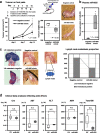Low levels of tumour suppressor miR-655 in plasma contribute to lymphatic progression and poor outcomes in oesophageal squamous cell carcinoma
- PMID: 30609933
- PMCID: PMC6320607
- DOI: 10.1186/s12943-018-0929-3
Low levels of tumour suppressor miR-655 in plasma contribute to lymphatic progression and poor outcomes in oesophageal squamous cell carcinoma
Abstract
Recent studies identified that low levels of tumour suppressor microRNAs (miRNAs) in plasma/serum relate to tumour progression and poor outcomes in cancers. We selected six candidates (miR-126, 133b, 143, 203, 338-3p, 655) of tumour suppressor miRNAs in oesophageal squamous cell carcinoma (ESCC) by a systematic review of NCBI database. Of these, miR-655 levels were significantly down-regulated in plasma of ESCC patients compared to healthy volunteers by test- and validation-scale analyses. Low levels of plasma miR-655 were significantly associated with lymphatic invasion, lymph node metastasis and advanced stage. Univariate and multivariate analysis revealed that the low level of plasma miR-655 was an independent risk factor of lymphatic progression and a poor prognostic factor. Overexpression of miR-655 in ESCC cells inhibited cell proliferation, migration, invasion and epithelial-mesenchymal transition. Increased plasma miR-655 levels by the subcutaneous injection significantly inhibited lymph node metastasis in mice. Low levels of miR-655 in plasma relate to lymphatic progression and poor outcomes, and the restoration of the plasma miR-655 levels might inhibit tumour and lymphatic progression in ESCC.
Keywords: Biomarker; Lymph node metastasis; Mouse model; Oesophageal squamous cell carcinoma; Plasma microRNA; Therapeutic agent.
Conflict of interest statement
Ethics approval
All experimental methods were carried out in accordance with relevant guidelines and regulations, such as the Declaration of Helsinki. Written informed consent was obtained from all patients to use their tissue specimens and blood samples. This study was approved by the institutional review boards of Kyoto Prefectural University of Medicine (ERB-C-319-1). The animal protocol was approved by the Institutional Animal Care and Use Committee of Kyoto Prefectural University of Medicine, and all experiments were conducted strictly in accordance to the National Institute of Health Guide for Care and Use of Laboratory Animals.
Consent for publication
Not applicable in this study.
Competing interests
The authors declare that they have no competing interests.
Publisher’s Note
Springer Nature remains neutral with regard to jurisdictional claims in published maps and institutional affiliations.
Figures


Similar articles
-
miR-877-3p as a Potential Tumour Suppressor of Oesophageal Squamous Cell Carcinoma.Anticancer Res. 2023 Jan;43(1):35-43. doi: 10.21873/anticanres.16131. Anticancer Res. 2023. PMID: 36585184
-
Downregulated MEG3 contributes to tumour progression and poor prognosis in oesophagal squamous cell carcinoma by interacting with miR-4261, downregulating DKK2 and activating the Wnt/β-catenin signalling.Artif Cells Nanomed Biotechnol. 2019 Dec;47(1):1513-1523. doi: 10.1080/21691401.2019.1602538. Artif Cells Nanomed Biotechnol. 2019. PMID: 30990378
-
Hsa_circ_0006948 enhances cancer progression and epithelial-mesenchymal transition through the miR-490-3p/HMGA2 axis in esophageal squamous cell carcinoma.Aging (Albany NY). 2019 Dec 26;11(24):11937-11954. doi: 10.18632/aging.102519. Epub 2019 Dec 26. Aging (Albany NY). 2019. PMID: 31881015 Free PMC article.
-
Low blood level of tumour suppressor miR-5193 as a target of immunotherapy to PD-L1 in gastric cancer.Br J Cancer. 2024 Mar;130(4):671-681. doi: 10.1038/s41416-023-02532-3. Epub 2023 Dec 26. Br J Cancer. 2024. PMID: 38148376 Free PMC article.
-
Molecular pathways in the development and treatment of oesophageal cancer.Best Pract Res Clin Gastroenterol. 2018 Oct-Dec;36-37:9-15. doi: 10.1016/j.bpg.2018.11.013. Epub 2018 Nov 23. Best Pract Res Clin Gastroenterol. 2018. PMID: 30551862 Review.
Cited by
-
Plasma miR-1254 as a predictive biomarker of chemosensitivity and a target of nucleic acid therapy in esophageal cancer.Cancer Sci. 2023 Jul;114(7):3027-3040. doi: 10.1111/cas.15830. Epub 2023 May 15. Cancer Sci. 2023. PMID: 37190912 Free PMC article.
-
Plasma microRNA profiles: identification of miR-1229-3p as a novel chemoresistant and prognostic biomarker in gastric cancer.Sci Rep. 2020 Feb 21;10(1):3161. doi: 10.1038/s41598-020-59939-8. Sci Rep. 2020. PMID: 32081926 Free PMC article.
-
Depletion of tumor suppressor miRNA-148a in plasma relates to tumor progression and poor outcomes in gastric cancer.Am J Cancer Res. 2021 Dec 15;11(12):6133-6146. eCollection 2021. Am J Cancer Res. 2021. PMID: 35018247 Free PMC article.
-
Human umbilical cord mesenchymal stem cell-derived extracellular vesicles carrying miR-655-3p inhibit the development of esophageal cancer by regulating the expression of HIF-1α via a LMO4/HDAC2-dependent mechanism.Cell Biol Toxicol. 2023 Aug;39(4):1319-1339. doi: 10.1007/s10565-022-09759-5. Epub 2022 Oct 12. Cell Biol Toxicol. 2023. PMID: 36222945
-
LncRNA XIST from the bone marrow mesenchymal stem cell derived exosome promotes osteosarcoma growth and metastasis through miR-655/ACLY signal.Cancer Cell Int. 2022 Oct 29;22(1):330. doi: 10.1186/s12935-022-02746-0. Cancer Cell Int. 2022. PMID: 36309693 Free PMC article.
References
-
- Mitchell PS, Parkin RK, Kroh EM, Fritz BR, Wyman SK, Pogosova-Agadjanyan EL, Peterson A, Noteboom J, O'Briant KC, Allen A, et al. Circulating microRNAs as stable blood-based markers for cancer detection. Proc Natl Acad Sci U S A. 2008;105:10513–10518. doi: 10.1073/pnas.0804549105. - DOI - PMC - PubMed
Publication types
MeSH terms
Substances
LinkOut - more resources
Full Text Sources
Medical

